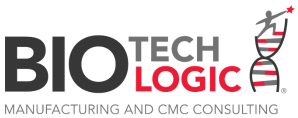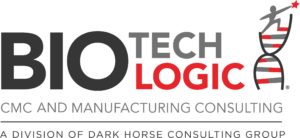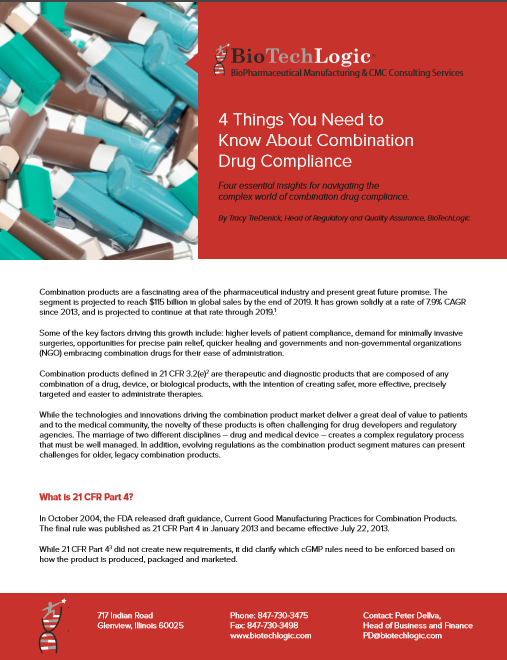
In 2016 we released a paper, “4 Things You Need to Know About Combination Drug Compliance.” This paper is still entirely relevant today, and we encourage you to download it, but it was a fairly basic overview of the combination drug product regulatory landscape at a time when many manufacturers were struggling with bringing their legacy combination products into compliance with 21 CFR Part 4.
Additionally, during this era, the FDA worked diligently to streamline compliance requirements for combination drugs—a pursuit that continues today. Given the complexity of the combination drug
approval process and often the sophistication of the products themselves, the FDA continues to work to offer clarification and direction, increasing efficiency and decreasing confusion within the product development and regulatory approval processes.
Although the majority of final and draft guidances released since our 2016 paper have been clarification-oriented efforts, the 2022 guidance declaring that ophthalmic drugs are now combination drugs arguably had the most sudden and dramatic impact.
Additionally, the 2019 draft guidance discussing how developers can bridge data from various stages of development was quite important, and we expect to see the finalization of that guidance early in 2023.
To update the information we shared in “4 Things You Need to Know About Combination Drug Compliance,” we have summarized the most significant combination drug product guidances in recent years, including the intent and impact of the guidances.
Ophthalmic Products Are Now Combination Drugs
Historically, ophthalmic drugs packaged with or in ophthalmic dispensers did not fall under the purview of 21 CFR Part 4 and were not regulated as combination products. However, in March 2022, in response to the Genus decision, the FDA determined in its final guidance that “the language […] indicating that ophthalmic dispensers are regulated as drugs when packaged with ophthalmic drugs is now obsolete because these articles meet the device definition.”
The new guidance, Certain Ophthalmic Products: Policy Regarding Compliance With 21 CFR Part 4, clearly establishes that ophthalmic drugs, including pending applications, approved products, and OTC monograph drugs, packaged with or in eye droppers, eye cups or other dispensers, are to be regulated as combination products.
Classification as a combination product adds regulatory requirements with which ophthalmic drug developers and manufacturers must familiarize themselves. To aid with the transition, the FDA said it would not act against applicants and manufacturers for 12 months after guidance publication, giving time for compliance related to the reclassification. But March 2023 is coming quickly, and likely some companies are still working to fully understand combination drug compliance requirements.
Additionally, the Agency is evaluating the application of part 820 quality system (QS) requirements to combination products that include low-risk device constituent parts. Until the FDA has further considered the application of these requirements to low-risk combination products, the FDA says that it generally does not intend to act on noncompliance with any applicable part 820 requirements for these ophthalmic products (again, low-risk device constituent parts).
Bridging for Combination Product Applications
In 2019, the FDA issued a draft guidance, Bridging for Drug-Device and Biologic-Device Combination Products, that provides information on how drug-device and biologic-device combination product sponsors can bridge data from earlier stages of development or other development programs to support an application.
The term bridging refers to establishing the scientific relevance of the information to support the combination product for which an applicant is seeking approval. Ultimately, the goal of bridging is to streamline the product’s development process.
The draft guidance provides a five-step analytical framework for identifying information gaps to inform a bridging and leveraging approach, which includes the following:
- Identifying differences between two combination products
- Identifying existing information about the proposed product
- Determining how information on the first product can be bridged to the second
- Determining gaps in that information and whether any other information could address those gaps
- Identifying any remaining gaps from the previous steps to determine what remains to be discussed in an application
Additionally, the FDA presents three case examples to illustrate how an applicant may apply the five-step framework:
- Bridging within an IND from a drug developed in a prefilled syringe to a drug developed in an auto-injector
- Bridging from one auto-injector (prototype 1) to another auto-injector (prototype 2) from the same drug— after Phase 3 studies have been completed but before NDA submission.
- Bridging data from a combination product that employs the same device combined with a different drug
FDA does offer a caveat that the amount of information that can be leveraged for bridging purposes depends on the specific combination product, and in some cases, bridging may not be possible.
This guidance was expected to be finalized by the end of 2022—a deadline that was not met. However, the guidance will likely be finalized early in 2023.
Premarket Pathways for Combination Products Guidance
Principles of Premarket Pathways for Combination Products Guidance for Industry and FDA Staff was finalized in January 2022 and offers high-level information about combination products, coordination within the Agency, and interactions between the FDA and sponsors. Specifically, the guidance discusses how combination products are reviewed before they are marketed and how to determine which type of premarket submissions may be appropriate for specific combination products.
This guidance did not change combination product regulatory requirements. Rather, it was created in response to a specific section within the 21st Century Cures Act (2016) that committed to enhancing clarity, predictability, eff ately onpremarket review of these products and that Agency thinking is aligned in conducting these reviews.
The guidance clarifies the following:
- The definition of a combination product
- How the FDA center that will have primary jurisdiction over a combination product is determined
- Basics of interacting with the FDA to secure approval of a combination product
- Basics of premarket regulation of combination products
Combination Drug Postmarketing Safety Reporting
Postmarketing Safety Reporting for Combination Products, finalized in July 2019, provides additional information for compliance with the final rule on postmarketing safety reporting (PMSR) requirements for combination products. PMSR aims to protect public health by ensuring that combination products are safe and effective and that consistent and complete reporting is performed while avoiding duplication.
Per this guidance, general considerations for combination product PMSR compliance include the following:
- Application type-based reporting requirements—these requirements apply to both combination product applicants and constituent part applicants, based on the application type under which the combination product or constituent part received marketing authorization.
- Constituent part-based reporting requirements—these reporting requirements apply only to combination product applicants and are based on the types of constituent parts included in the combination product.
- Information sharing—this rule requires discrete constituent part applicants to share certain postmarketing safety information with one another.
- Submission process—this process specifies how combination and constituent part applicants must submit PMSR information to the FDA.
- Streamlined reporting offers ways to satisfy certain reporting requirements within the same report.
- Record retention—this specifies which records of combination products and constituent part applicants must maintain and how long they must maintain the information.
Closing Comments
The combination drug product regulatory landscape will certainly continue to evolve, particularly as new technologies and modalities are developed and the sector continues to grow.
In 2021, the combination drug sector exceeded $118.13 billion. Additionally, as patients and physicians seek minimally invasive procedures, the market is expected to grow at a compound annual growth rate (CAGR) of 8.8% between 2022 and 2030.1
Evolving regulation can be daunting, and given healthy growth within the market, delays due to regulatory misunderstandings can be costly. If BioTechLogic can help support your project, don’t hesitate to contact us.
Reference:
- Drug-Device Combination Products Market Size, Share & Trends Analysis Report By Product (Transdermal Patches, Inhalers, Infusion Pumps, Drug Eluting Stents, Antimicrobial Catheters), And Segment Forecasts, 2022 – 2030, Grandview Research







